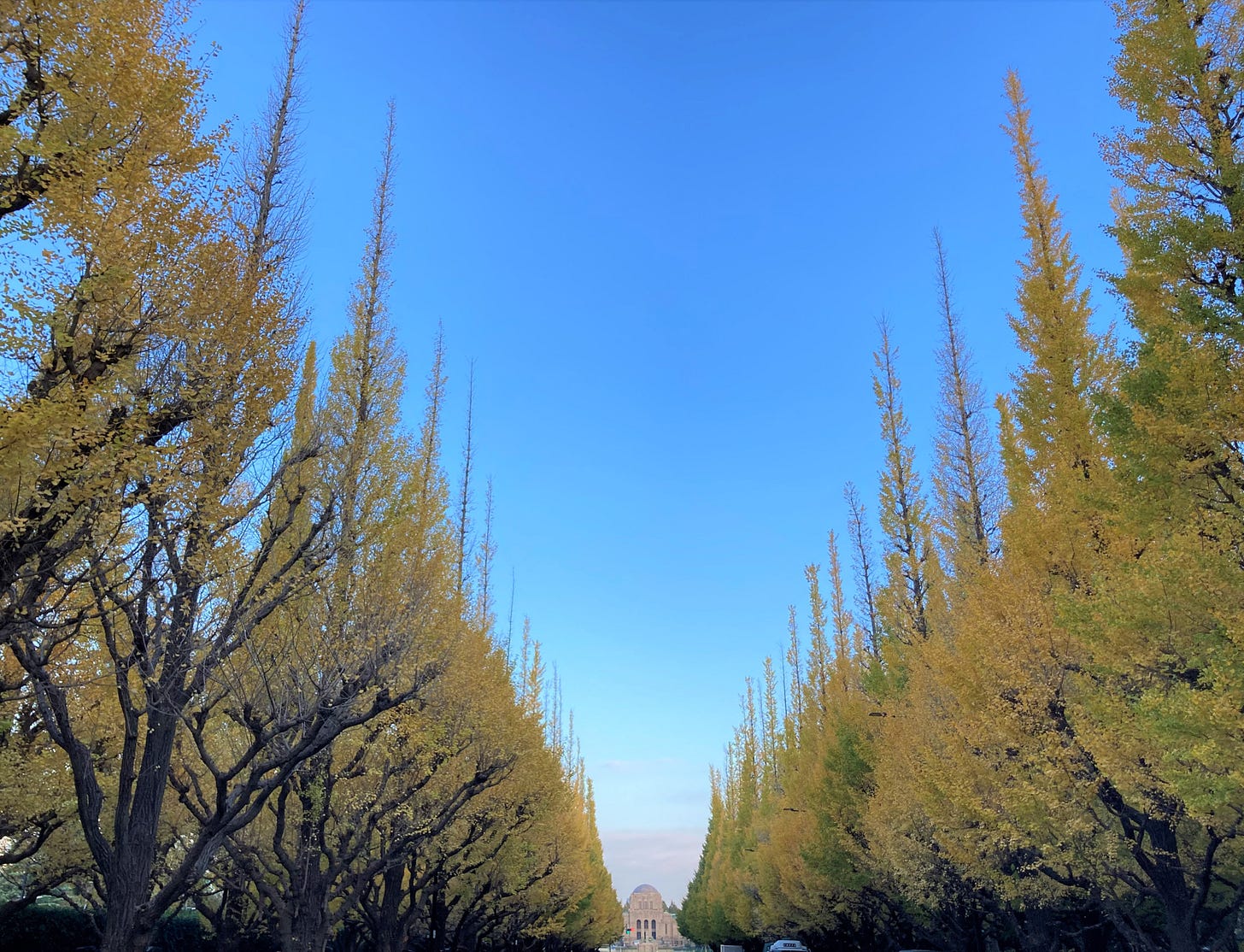#32 Ginkgo trees time
These are what and where you can enjoy towards the end of the autumn leaves season.
Restrictions on foreigners entering the country have eased since the 11th of October. More foreign travellers are seen in central Tokyo, and the situation seems to be getting back to normal gradually. The real autumn seems to be coming down in Tokyo. The ginkgo trees are at their best. Ginkgo trees are the most appealing among trees in autumn leaf colours. In Tokyo, there are various places to enjoy ginkgo trees around this season. This week I will write about the ginkgo season in Tokyo.
Everybody has obsessions. I have to admit that I have an obsession with ginkgo trees. I hated them simply because I have bad memories from my school days of ginkgo nuts smelling rotten and having to deal with their fallen leaves as a school duty. But I started looking at ginkgo trees from a different angle as I got older, especially after I started to take pictures. Contrasts of blue skies and bright yellow colours encourage me to take photographs and search for more suitable places to take pictures. Looking back at the archive of my iPhone album, I can see so many ginkgo tree-related photos.
<Close up>
First of all, one question hit my mind. Why are there certain places, for instance, in Tokyo, where we can see beautiful ginkgo trees? The answer is very simple, rows of ginkgo trees here in Tokyo are mostly artificial. They didn’t grow naturally, and humans planted them for certain purposes. Ginkgo trees have a long history of planting. Because of the tree's fast growth and its resistance to burning and cold, its history as a garden plant is long, with records showing that it was cultivated as early as the Muromachi period (1336-1573). Whether trees are natural or artificial, I don’t mind as long as it is beautiful and photogenic. In Japan, I just can’t name any plants with yellow colour leaves which are suitable for photography.
Gingko trees in the outer garden of Meiji Shrine are too famous not only among Japanese people but also among foreign visitors. If you happen to be in Japan at the right time, you should spare just one hour and visit. The outer garden of Meiji Shrine was built with donations from the people of Japan, donated trees and the hard work of youth volunteer groups to pass on the legacy of Emperor Meiji and his empress, to future generations for many years to come. This area was fully designed and preserved in a good manner for many years. The Meiji Memorial Picture Gallery is the iconic building in the outer garden of the Meiji Shrine.
Gingko trees in the outer garden of Meiji Shrine are well-calculated and designed. The distance of the ginkgo tree line is approximately 300 metres. In between, 146 ginkgo trees are planted at intervals of almost 9 metres. In addition to that, the ginkgo is planted in perspective, calculating the height of the trees and the gradient of the slowly descending path towards the Picture Gallery. All these factors make the ginkgo in the outer garden of Meiji Shrine something special. So you shouldn’t fail to take good pictures. It is just the question of when you take photos since it is very difficult to see it without people.
A couple of days ago, I visited very early in the morning to avoid the crowds. It was an acceptable number of people who came to take photos. But the light wasn’t good enough to extract the best of yellow colours. It is just what to give up and what to accept. And ginkgo leaves started falling and I felt that I should have come one week earlier. But you still can enjoy the atmosphere for another week or so.
One thing which ginkgo trees differ from cherry blossoms is that they have all different timing when it comes to the best timing. I am not a scientist, but it seems that the best timing is different, even though they grow in the same area. Now that the ginkgo trees in the outer garden of Meiji Shrine are nearly over, there should be somewhere you still can enjoy.
Another recommendable place for the ginkgo tree is the National Showa Memorial Park in the west of Tokyo. The National Showa Memorial Park was built on the site of the former Tachikawa Airfield as part of the 50th anniversary of Emperor Showa's reign, covering a total area of 180ha. It is located 35 km to the west of central Tokyo and it takes just less than an hour by Chuo Line from Tokyo station. It is a huge park and you can enjoy different flowers throughout the year. The ginkgo trees here are located just after the entrance and the beautiful ginkgo trees will welcome you. You have to pay the admission fee of 450 Yen for those over 15 years old. For those who are less is free and for those over 65 years is 210 Yen.
There are lots of English sites which give you the idea where to go. But these two places are ones I strongly recommend if you have free time. Autumn leaves hunting in the mountains is rather difficult due to the timing differs depending on the temperature and the weather pattern. But the timing for the ginkgo tree is not difficult as those in the mountain. The duration of the peak time is longer and access to the site is easier. Generally speaking the autumn leaves of ginkgo trees in Tokyo can be seen in the second half of November.
It won’t be too late if you haven’t been to the sites yet. You will find their beauty by the end of this month. Why don’t you spare a half day and enjoy the yellow carpets and curtains?







